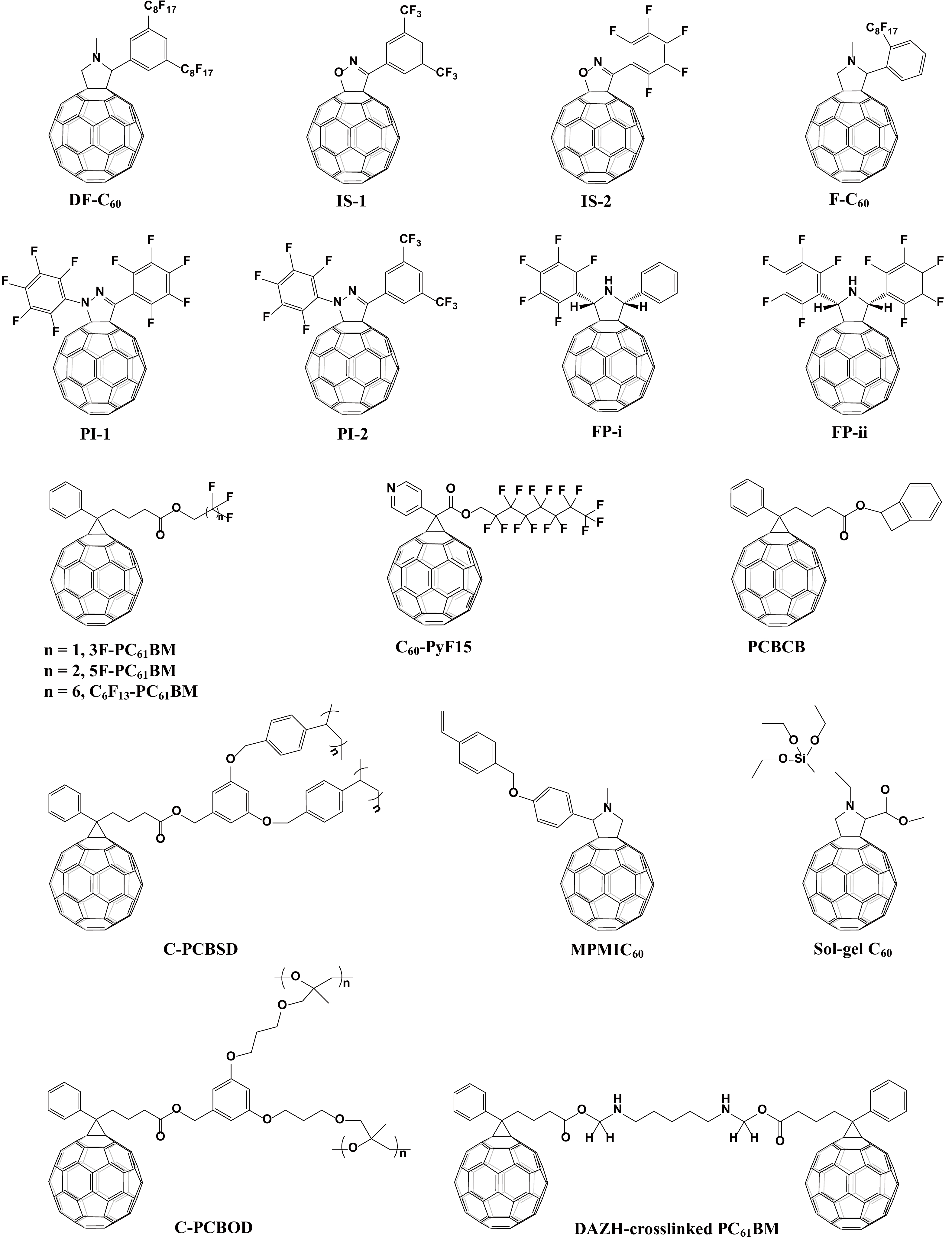| Citation: |
Lingbo Jia, Lixiu Zhang, Liming Ding, Shangfeng Yang. Using fluorinated and crosslinkable fullerene derivatives to improve the stability of perovskite solar cells[J]. Journal of Semiconductors, 2021, 42(12): 120201. doi: 10.1088/1674-4926/42/12/120201
****
L B Jia, L X Zhang, L M Ding, S F Yang, Using fluorinated and crosslinkable fullerene derivatives to improve the stability of perovskite solar cells[J]. J. Semicond., 2021, 42(12): 120201. doi: 10.1088/1674-4926/42/12/120201.
|
Using fluorinated and crosslinkable fullerene derivatives to improve the stability of perovskite solar cells
DOI: 10.1088/1674-4926/42/12/120201
More Information
-
References
[1] Zheng X, Hou Y, Bao C, et al. Managing grains and interfaces via ligand anchoring enables 22.3%-efficiency inverted perovskite solar cells. Nat Energy, 2020, 5, 131 doi: 10.1038/s41560-019-0538-4[2] Fang Z, Zeng Q, Zuo C, et al. Perovskite-based tandem solar cells. Sci Bull, 2021, 6, 621 doi: 10.13140/RG.2.2.12553.65126[3] Cheng Y, Ding L. Pushing commercialization of perovskite solar cells by improving their intrinsic stability. Energy Environ Sci, 2021, 14, 3233 doi: 10.1039/D1EE00493J[4] Chu L, Ding L. Self-assembled monolayers in perovskite solar cells. J Semicond, 2021, 42, 090201 doi: 10.1088/1674-4926/42/9/090201[5] Shang Y, Fang Z, Hu W, et al. Efficient and photostable CsPbI2Br solar cells realized by adding PMMA. J Semicond, 2021, 42, 050501 doi: 10.1088/1674-4926/42/5/050501[6] Cheng M, Zuo C, Wu Y, et al. Charge-transport layer engineering in perovskite solar cells. Sci Bull, 2020, 65, 1237 doi: 10.1016/j.scib.2020.04.021[7] Cheng Y, Yang Q D, Ding L. Encapsulation for perovskite solar cells. Sci Bull, 2021, 66, 100 doi: 10.1016/j.scib.2020.08.029[8] Wang R, Mujahid M, Duan Y, et al. A review of perovskites solar cell stability. Adv Funct Mater, 2019, 29, 1808843 doi: 10.1002/adfm.201808843[9] Li X, Zhang F, He H, et al. On-device lead sequestration for perovskite solar cells. Nature, 2020, 578, 555 doi: 10.1038/s41586-020-2001-x[10] Jia L, Chen M, Yang S. Functionalization of fullerene materials toward applications in perovskite solar cells. Mater Chem Front, 2020, 4, 2256 doi: 10.1039/D0QM00295J[11] Liu X, Lin F, Chueh C C, et al. Fluoroalkyl-substituted fullerene/perovskite heterojunction for efficient and ambient stable perovskite solar cells. Nano Energy, 2016, 30, 417 doi: 10.1016/j.nanoen.2016.10.036[12] Rajagopal A, Liang P W, Chueh C C, et al. Defect passivation via a graded fullerene heterojunction in low-bandgap Pb-Sn binary perovskite photovoltaics. ACS Energy Lett, 2017, 2, 2531 doi: 10.1021/acsenergylett.7b00847[13] Sandoval-Torrientes R, Pascual J, Garcia-Benito I, et al. Modified fullerenes for efficient electron transport layer-free perovskite/fullerene blend-based solar cells. ChemSusChem, 2017, 10, 2023 doi: 10.1002/cssc.201700180[14] Chang C Y, Wang C P, Raja R, et al. High-efficiency bulk heterojunction perovskite solar cell fabricated by one-step solution process using single solvent: synthesis and characterization of material and film formation mechanism. J Mater Chem A, 2018, 6, 4179 doi: 10.1039/C7TA07939G[15] Jia L, Huang F, Ding H, et al. Double-site defect passivation of perovskite film via fullerene additive engineering toward highly efficient and stable bulk heterojunction solar cells. Nano Today, 2021, 39, 101164 doi: 10.1016/j.nantod.2021.101164[16] Zhu Z, Chueh C C, Lin F, et al. Enhanced ambient stability of efficient perovskite solar cells by employing a modified fullerene cathode interlayer. Adv Sci, 2016, 3, 1600027 doi: 10.1002/advs.201600027[17] Xing Z, Li S H, Xie F F, et al. Mixed fullerene electron transport layers with fluorocarbon chains assembling on the surface: a moisture-resistant coverage for perovskite solar cells. ACS Appl Mater Interfaces, 2020, 12, 35081 doi: 10.1021/acsami.0c10074[18] Yuan Q, Han D, Yi S, et al. Fluorinated fulleropyrrolidine as universal electron transport material for organic-inorganic and all-inorganic perovskite solar cells. Org Electron, 2020, 77, 105492 doi: 10.1016/j.orgel.2019.105492[19] Watson B L, Rolston N, Bush K A, et al. Cross-linkable, solvent-resistant fullerene contacts for robust and efficient perovskite solar cells with increased Jsc and Voc. ACS Appl Mater Interfaces, 2016, 8, 25896 doi: 10.1021/acsami.6b06164[20] Wojciechowski K, Ramirez I, Gorisse T, et al. Cross-linkable fullerene derivatives for solution-processed n–i–p perovskite solar cells. ACS Energy Lett, 2016, 1, 648 doi: 10.1021/acsenergylett.6b00229[21] Li M, Chao Y H, Kang T, et al. Enhanced crystallization and stability of perovskites by a cross-linkable fullerene for high-performance solar cells. J Mater Chem A, 2016, 4, 15088 doi: 10.1039/C6TA06152D[22] Tao C, Van Der Velden J, Cabau L, et al. Fully solution-processed n–i–p-like perovskite solar cells with planar junction: how the charge extracting layer determines the open-circuit voltage. Adv Mater, 2017, 29, 1604493 doi: 10.1002/adma.201604493[23] Li M, Wang Z K, Kang T, et al. Graphdiyne-modified cross-linkable fullerene as an efficient electron-transporting layer in organometal halide perovskite solar cells. Nano Energy, 2018, 43, 47 doi: 10.1016/j.nanoen.2017.11.008[24] Tremblay M H, Schutt K, Pulvirenti F, et al. Benzocyclobutene polymer as an additive for a benzocyclobutene-fullerene: application in stable p–i–n perovskite solar cells. J Mater Chem A, 2021, 9, 9347 doi: 10.1039/D0TA07733J[25] Kang T, Tsai C M, Jiang Y H, et al. Interfacial engineering with cross-linkable fullerene derivatives for high-performance perovskite solar cells. ACS Appl Mater Interfaces, 2017, 9, 38530 doi: 10.1021/acsami.7b11795[26] Li M, Yang Y G, Wang Z K, et al. Perovskite grains embraced in a soft fullerene network make highly efficient flexible solar cells with superior mechanical stability. Adv Mater, 2019, 31, 1901519 doi: 10.1002/adma.201901519[27] Qiu W, Bastos J P, Dasgupta S, et al. Highly efficient perovskite solar cells with crosslinked PCBM interlayers. J Mater Chem A, 2017, 5, 2466 doi: 10.1039/C6TA08799J -
Supplements
 2021-120201-suppl.pdf
2021-120201-suppl.pdf

-
Proportional views






 DownLoad:
DownLoad:
















